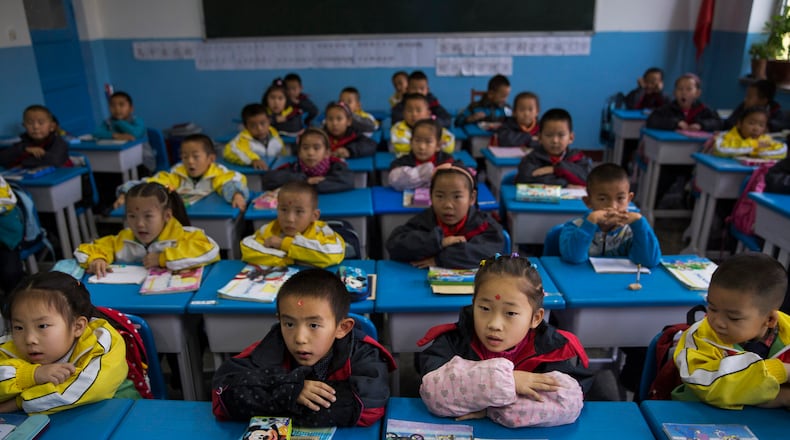With schools starting back this week, parents fret about whether their child’s teacher will be engaging, how much homework to expect, and if their child will be able to balance classes with soccer or band.
In East Asian countries, parents voice a singular worry: Will their child learn? Academics eclipse all other activities, and the children’s success depends not only on their own dogged effort, but that of the parents as well.
The difference may explain the performance gap between East Asian countries and the United States. For example, Georgia released exam results earlier this month showing less than half of students, typically around 40 percent on each grade level, scored proficient or better in math and English/language arts.
According to a research scholar on East Asian education, this lagging performance, even when comparing middle-class students, will not change unless we upend two beliefs: Teachers are responsible for student achievement, and parents play a supportive rather than the primary role.
"We have been trying to fix all the things about education that adults control. Let's step back and look at the children. They bring something to the table, too," said Cornelius N. Grove, author of the new book, "The Drive to Learn: What the East Asian Experience Tells Us about Raising Students Who Excel."
And what children bring — or don’t bring, in the case of U.S. students, he says — is a receptiveness to learning and a moral and cultural imperative to excel.
In his earlier book, "The Aptitude Myth," Grove challenged the assumption that school performance is determined by innate aptitude. Studies show that, in fact, East Asian students in the U.S. don't enter kindergarten with a cognitive edge. Yet they end up surpassing classmates because they believe achievement derives from effort, not genes. Students who fail an algebra test here often say, "I'm just not good at math." East Asian students use failure to figure out what they don't know and redirect their study plan.
Then, there are Asian parents, made infamous by Yale professor Amy Chua's book "Battle Hymn of the Tiger Mother" in which she chronicled forcing her two daughters to practice their instruments for six hours and threatening to dismantle and give away one's doll house if she didn't nail "The Little White Donkey."
Chua's Draconian standards, which prompted some critics to blast her methods as "abuse," seem to have paid off, said Grove. Chua's youngest child attends Harvard, while the older graduated from Harvard and is a U.S. Army officer working toward a law degree at Yale. Both young women contend they always knew they were loved and plan to raise their own kids with similar high expectations.
Grove said Asian parents show so much passion and involvement because they see themselves as their children’s primary educators, explaining, “In Asia, parents retain this responsibility. They see the teacher as supporting their efforts. They very much respect anyone with knowledge, so teachers get a great deal of respect.”
And that deep cultural respect permeates classrooms where East Asian students arrive with upturned faces and pencils in hand to take notes and listen to their teachers, seldom asking questions, a trait often derided as passive and, thus, as ineffectual learning. “Here, we assume that if students are talking and moving around, they are mentally engaged and learning, but that doesn’t necessarily follow,” said Grove. “East Asian students believe that a class session is their opportunity to get expert knowledge, so they don’t interrupt the teacher.” Once class is over, students often continue researching the topics on their own, frequently meeting informally with classmates for joint inquiry. It’s not uncommon for them to approach the teacher outside of class time to discuss what their further studies revealed.
It is a uniquely American idea that schools must provide sports, clubs, theaters, and pep rallies alongside academics to make school palatable to children, said Grove. Extracurricular activities are far less common in East Asia. There, children are much more receptive to classroom learning because it's how they become their best selves and useful family and community members.
At the end of an hourlong phone discussion, I asked Grove whether American parents, many of whom want their kids to have fun at school and expect teachers to understand when students miss class or assignments due to baseball tournaments or family vacations, would ever embrace a model that increases their responsibilities?
Yes, he said, if parents have courage. “You must get out of the habit of bolstering your children’s self-esteem when they don’t do well. That doesn’t happen in East Asia,” he said. And parents have to rethink the “well-rounded child” ideal, which is widespread here but has left American children far behind their East Asian peers academically.
Grove rejects the criticism that the East Asian education model will lead to less creativity and innovation. “We are not short of entrepreneurs in this country,” he said. “We have masses of young people who aren’t able to do simple math, who have trouble reading a sentence. That is our bigger problem and the one I am trying to help solve.”
About the Author
Keep Reading
The Latest
Featured




